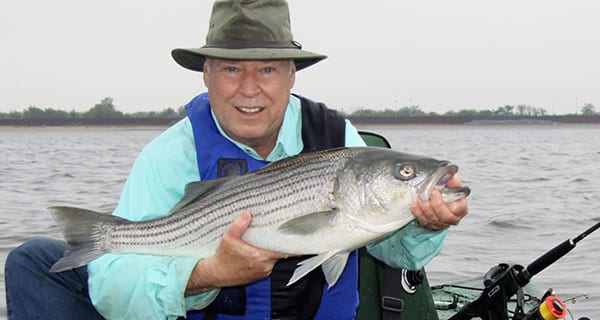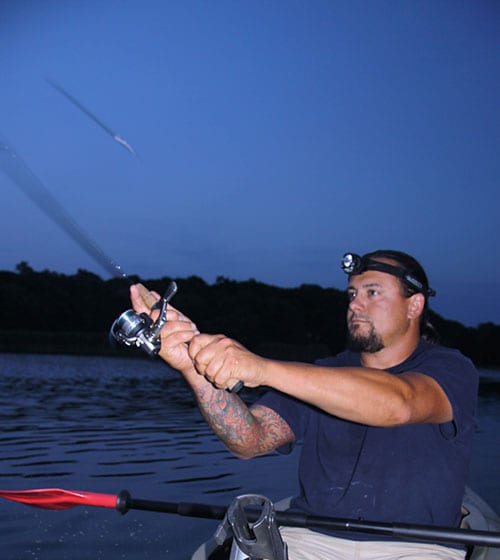
By Tom Schlichter
Kayak fishing has exploded in popularity in recent years, and with good reason. For starters, they can go where no boat has gone before, crossing skinny flats that eat props and they easily glide up shallow rivers and tidal creeks bordered by impenetrable phragmites or soggy marsh. Kayaks also allow for a quiet, stealthy attack, a point taken to heart by many who paddle the flats to sight-cast at dawn and dusk, or plug quiet backwaters on the graveyard shift.
Of course, there are practical reasons to fish from a kayak. They are, for example, easy to transport and launching is never a problem as long as you have access to the water. Planning a vacation trip to the Hudson Valley, Catskills, Adirondacks or Maine? Put your yak on the rack and plan to fish while your loved ones sleep late. Toss in the esoteric feeling of communing with Nature while sitting almost eye-to-eye with your quarry, plus the exercise expended, pollution avoided and gas money saved while providing paddle power, and ‘yaking starts to look like a pretty good deal.
To be sure, kayaking isn’t motor boating, or even sailing, for that matter. Still, today’s models are lightweight, surprisingly stable and outfitted for fishing. Whether made of Kevlar, fiberglass or space-age plastic, they are virtually indestructible. At roughly $300 to $2,500, depending on the brand, model and extras, today’s kayaks are also relatively affordable. In a nutshell, entry into the game has never been more easy or safe – and you don’t need a trailer.
PIMP MY ‘YAK
Determining the type of kayak you’ll want to fish from is the logical starting point for newbees. For fishing, there are basically two types from which to choose: sit-ins and sit-on-tops.

Sit-ins are exactly what they sound like. You sit inside the cockpit and paddle. Streamlined and fast, this style is great for covering a lot of water and slicing through challenging currents. It also offers some protection from the elements since you are seated inside the cockpit, which makes it suitable for fishing during the cooler parts of the season.
Sit-on-top kayaks by comparison, feature a raised seating platform that gets you up above the water, generally offer more storage area in the cockpit, and are built a little wider for added stability. Sit-on-tops also have the advantage of allowing anglers to sit with their legs extended over the side, and are easier to reenter if you happen to fall off. Most anglers favor the sit-on-tops but both styles have their fans. As a rule, shorter model kayaks, those measuring 12-foot or less, are preferred because they allow you to play a fish around the bow or stern whereas in the longer models you’ll need to maneuver the ‘yak to keep a fish from going side-to-side.
When it comes to rigging a kayak for fishing, you can load up, go bare bones or settle someplace in-between. My 12 foot, two-person sit-in is so old the manufacturer’s brand markings have worn away but I’m still catching from it each and every year. When I use it to fish, I carry one rod, a small, clear Plano tackle box, a couple bottles of water, and a mesh bag that hangs over the side in which to place the occasional keeper.
The newest model kayaks, by comparison, come with or offer as options virtually everything you need to turn your kayak into a stealthy fishing machine. With pedal drives, bungee tie downs, flush-mounted rod holders, dry storage hatches, livewells, mesh-covered hatches, drink holders molded into the raised seat platform, and a plastic milk crate style storage box used to hold additional gear in the rear of sit-on models, these vessels leave owners wanting for almost nothing but fishy action during the course of a trip.

There are plenty of other accessories you’ll want to think about but how many to spring for depends largely on the way you fish. Adding too much to your vessel is just a guarantee that you’ll get tangled up in gear. Additional rod holders are always worth consideration. If you like to fish at anchor, a trolley setup that runs an anchor line from the bow to amidships is a must. If you plan to fish in areas where strong currents are the rule, a sea sock will help slow your drift. In big water, a paddle leash is also a good idea as it will allow you to drop your paddle and start casting immediately as fish begin to surface. A small electric motor and fish-finder are other possibilities. Should your launch site be a fair distance away from the parking area, a wheeled kayak cart might be a good idea.
KAYAK FISHING AND SAFETY TIPS
Of course, you’ll want to wear a personal flotation device at all times while aboard a kayak, and you should keep on your body in a dry pouch any medication or important items needed should you and your craft become separated. Tether anything you don’t want to loose, and strap a whistle around your neck because a loud toot carries farther across the waves than a yelp for help. As in all boating endeavors, let common sense be your guide. Wear appropriate clothing for the conditions you’ll encounter, bring along plenty of sunscreen because there’s no canopy to hide under, stay out of busy channels, and avoid outgoing tides in inlet waters.
As for specific fishing tips, there are a few points to keep in mind. Because you’ll be so low to the water, choose a stiff rod of at least seven feet in length for a primary stick. This will provide extra leverage on the hook set and allow the line to be worked around the bow or stern when a big fish powers under the boat and surfaces on the opposite side. I like to keep a tight drag when fishing from a kayak. Because the ‘yak is lightweight, big fish actually tow and spin it during the fight, tiring themselves out. A secure drag also helps keep monsters under control as you reach with the net or gripper.
Be aware, too, that kayaks don’t have the speed – and you probably don’t generate enough power – to race toward roving schools of breaking fish. You’re better off easing a kayak into the path of fast moving species like bluefish or false albacore than you are trying to chase them down. Just get in line with the breaking schools and let them work toward you. As in most fishing situations, a little patience goes a long way toward hooking-up.









